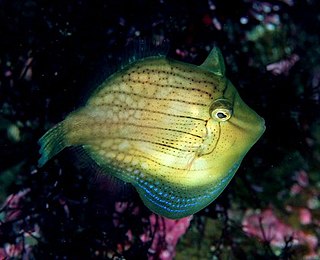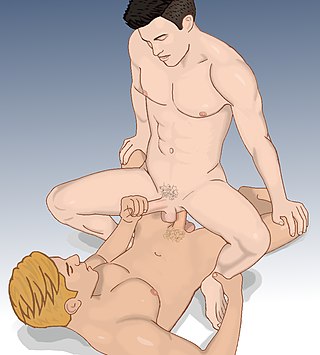
BDSM is a variety of often erotic practices or roleplaying involving bondage, discipline, dominance and submission, sadomasochism, and other related interpersonal dynamics. Given the wide range of practices, some of which may be engaged in by people who do not consider themselves to be practising BDSM, inclusion in the BDSM community or subculture often is said to depend on self-identification and shared experience.

Fisting—also known as fist fucking (FF), handballing, and brachioproctic or brachiovaginal insertion—is a sexual activity that involves inserting one or more hands into the rectum or the vagina. Fisting may be performed on oneself (self-fisting) or performed on one person by another. People who engage in fisting are often called "fisters".

Bondage, in the BDSM subculture, is the practice of consensually tying, binding, or restraining a partner for erotic, aesthetic, or somatosensory stimulation. A partner may be physically restrained in a variety of ways, including the use of rope, cuffs, bondage tape, or self-adhering bandage.

Leather subculture denotes practices and styles of dress organized around sexual activities that involve leather garments, such as leather jackets, vests, boots, chaps, harnesses, or other items. Wearing leather garments is one way that participants in this culture self-consciously distinguish themselves from mainstream sexual cultures. Many participants associate leather culture with BDSM practices and its many subcultures. For some, black leather clothing is an erotic fashion that expresses heightened masculinity or the appropriation of sexual power; love of motorcycles, motorcycle clubs and independence; and/or engagement in sexual kink or leather fetishism.

Sadism and masochism, known collectively as sadomasochism, are the derivation of pleasure from acts of respectively inflicting or receiving pain or humiliation. Practitioners of sadomasochism may seek sexual pleasure from their acts. While the terms sadist and masochist refer respectively to one who enjoys giving and receiving pain, some practitioners of sadomasochism may switch between activity and passivity.

A handkerchief is a form of a kerchief or bandanna, typically a hemmed square of thin fabric which can be carried in the pocket or handbag for personal hygiene purposes such as wiping one's hands or face, or blowing one's nose. A handkerchief is also sometimes used as a purely decorative accessory in the breast pocket of a suit; it can then be called a pocket square. A handkerchief is also an important accessory in many folk-dances in many regions like the Balkans and the Middle East; an example of a folk-dance featuring handkerchiefs is the Greek Kalamatianós.

Folsom Street Fair (FSF) is an annual BDSM and leather subculture street fair, held in September that concludes San Francisco's "Leather Pride Week". The Folsom Street Fair, sometimes referred to simply as "Folsom", takes place on the last Sunday in September, on Folsom Street between 8th and 13th Streets, in San Francisco's South of Market district.

Silver or metallic gray is a color tone resembling gray that is a representation of the color of polished silver.

Lavender is a light shade of purple or violet. It applies particularly to the color of the flower of the same name. The web color called lavender is displayed adjacent—it matches the color of the palest part of the flower; however, the more saturated color shown as floral lavender more closely matches the average color of the lavender flower as shown in the picture and is the tone of lavender historically and traditionally considered lavender by average people as opposed to website designers. The color lavender might be described as a medium purple, a pale bluish purple, or a light pinkish-purple. The term lavender may be used in general to apply to a wide range of pale, light, or grayish-purples, but only on the blue side; lilac is pale purple on the pink side. In paints, the color lavender is made by mixing purple and white paint.

Lime is a color that is a shade of yellow-green, so named because it is a representation of the color of the citrus fruit called limes. It is the color that is in between the web color chartreuse and yellow on the color wheel. Alternate names for this color included yellow-green, lemon-lime, lime green, or bitter lime.

The Leather Archives & Museum (LA&M) is a community archives, library, and museum located in the Rogers Park neighborhood of Chicago, Illinois. Founded by Chuck Renslow and Tony DeBlase in 1991, its mission is "making leather, kink, BDSM, and fetish accessible through research, preservation, education and community engagement." The LA&M is a leading conservator of queer erotic art. Its permanent collection features some of the most iconic LGBT artists of the twentieth century, including most artwork by Bill Schmeling and many works by Dom Orejudos.
Over the course of its history, the LGBT community has adopted certain symbols for self-identification to demonstrate unity, pride, shared values, and allegiance to one another. These symbols communicate ideas, concepts, and identity both within their communities and to mainstream culture. The two symbols most recognized internationally are the pink triangle and the rainbow flag.

Clothing fetishism or garment fetishism is a sexual fetish that revolves around a fixation upon a particular article or type of clothing, a particular fashion or uniform, or a person dressed in such a style.

In human sexuality, top, bottom, and versatile are roles during sexual activity, especially between two men. A top is usually a person who penetrates, a bottom is usually one who receives penetration, and someone who is versatile engages in either or both roles. These terms may be elements of self-identity that indicate an individual's usual preference and habits, but might also describe broader sexual identities and social roles.
Chicken can be used, usually by gay men referring to other gay men, to mean a young gay man or young-appearing gay man.

BDSM is a frequent theme in culture and media, including in books, films, television, music, magazines, public performances and online media.

Guy Baldwin is an American psychotherapist, author, activist, and educator specializing in issues of particular relevance to the BDSM and leather communities. Based in Los Angeles, he maintains that inclusion of non-injurious elements of sadomasochism in a consenting sexuality does not itself indicate or confirm mental illness or psycho-sexual dysfunction.

REX was an American visual artist and illustrator closely associated with gay fetish art of 1970s and 1980s New York and San Francisco. He avoided photographs and did not discuss his personal life. His drawings influenced gay culture through graphics made for nightclubs including the Mineshaft and his influence on artists such as Robert Mapplethorpe. Much censored, he remained a shadowy figure, saying that his drawings "defined who I became" and that there are "no other 'truths' out there". REX died in Amsterdam in late March 2024.

Domingo Francisco Juan Esteban "Dom" Orejudos, Secundo, also widely known by the pen names Etienne and Stephen, was an openly gay artist, ballet dancer, and choreographer, best known for his ground-breaking masculine gay male erotica beginning in the 1950s. Along with artists George Quaintance and Touko Laaksonen – with whom he became friends – Orejudos' leather-themed art promoted an image of gay men as strong and masculine, as an alternative to the then-dominant stereotype as weak and effeminate. With his first lover and business partner Chuck Renslow, Orejudos established many landmarks of late-20th-century gay male culture, including the Gold Coast bar, Man's Country bathhouse, the International Mr. Leather competition, Chicago's August White Party, and the magazines Triumph, Rawhide, and Mars. He was also active and influential in the Chicago ballet community.
Alan Selby (1929–2004), born Alan Henry Sniders, was an English-born American gay businessman and leader in the San Francisco leather community. He was known by many as "the Mayor of Folsom Street". He claimed to have created the first hanky code with his business partners at Leather 'n' Things in 1972, when their bandana supplier inadvertently doubled their order and the expanded code would help them sell the extra colors they had received. However, other sources dispute this being the origin of the hanky code.




















